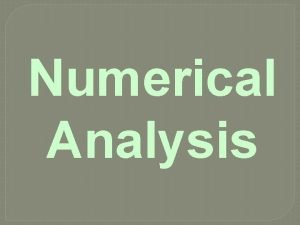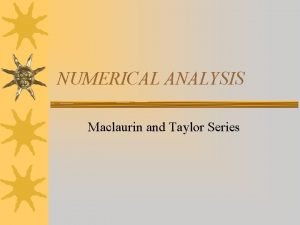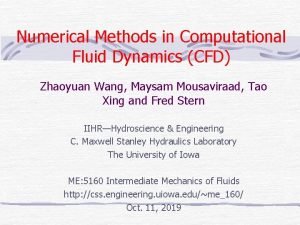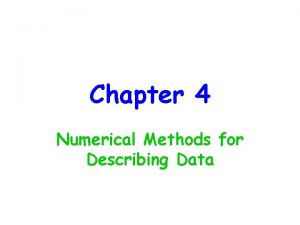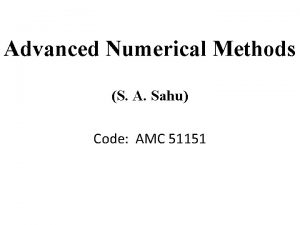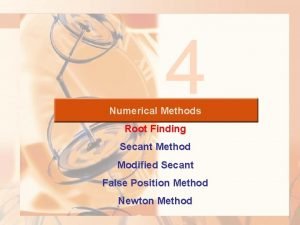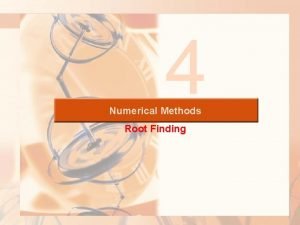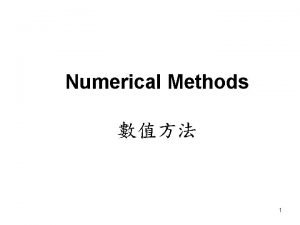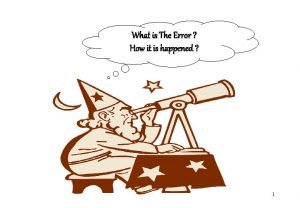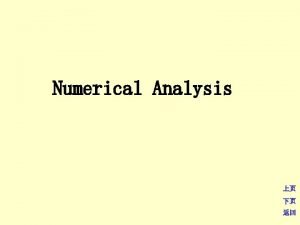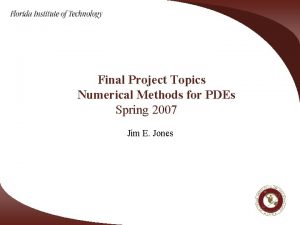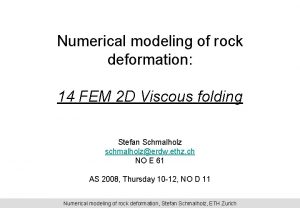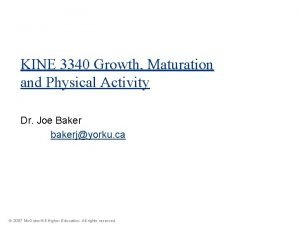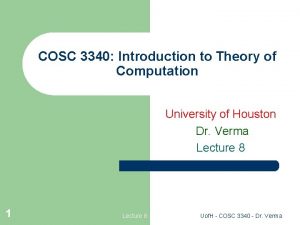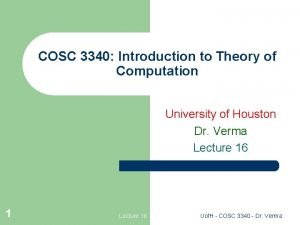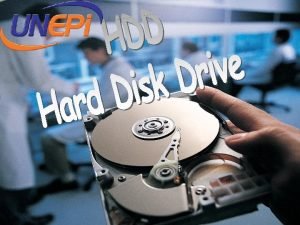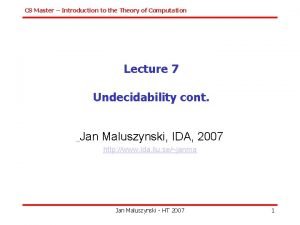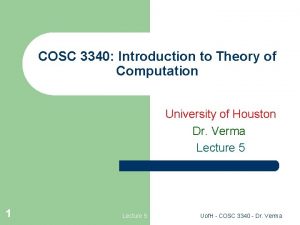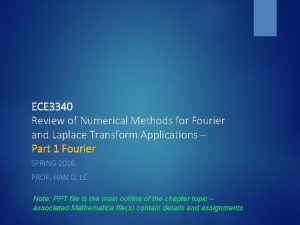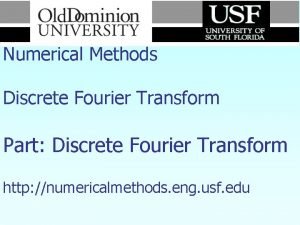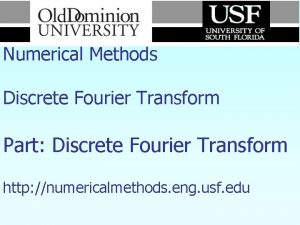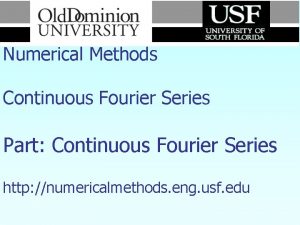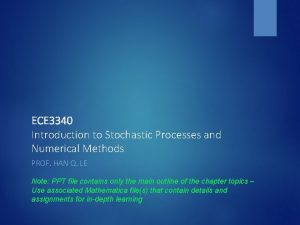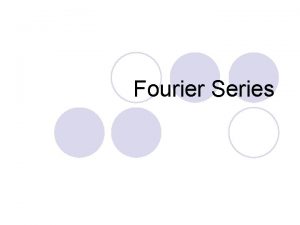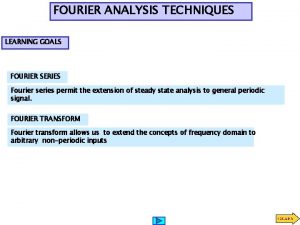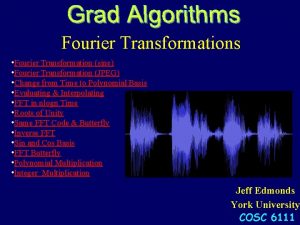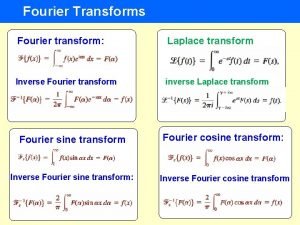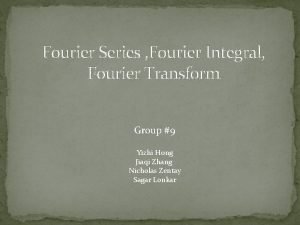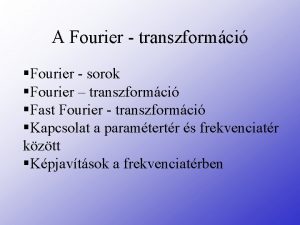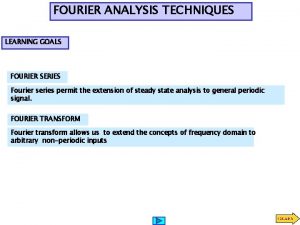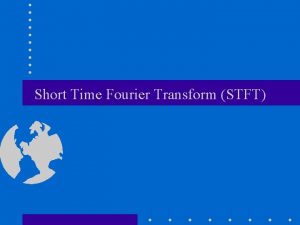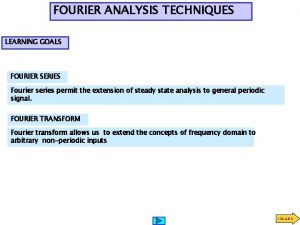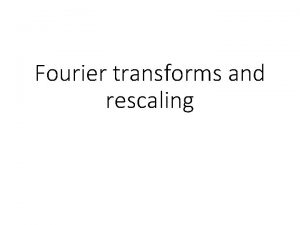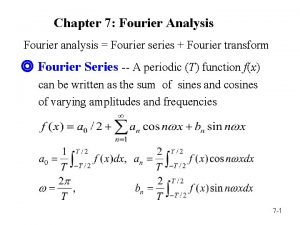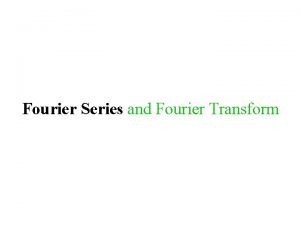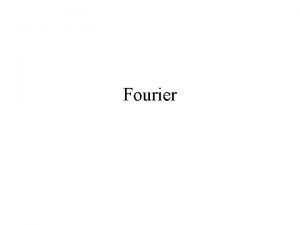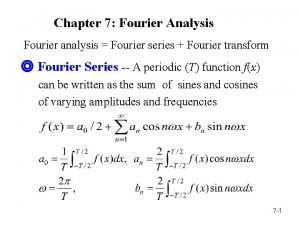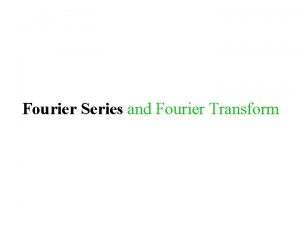ECE 3340 Review of Numerical Methods for Fourier




































- Slides: 36

ECE 3340 Review of Numerical Methods for Fourier and Laplace Transform Applications Part 2 Laplace PROF. HAN Q. LE Note: PPT file is the main outline of the chapter topic – associated Mathematica file(s) contain details and assignments

Remember this question? Which one is periodic and which one is not? (a) (b)

This is for real Which one is strictly periodic and which one is not?

Remember these circuits?

Consider this circuit that has no resistors, no dissipative elements (things that absorb power or energy permanently and not give back to the circuit). Assume perfect capacitor and perfect inductor. Then switch A is opened at time t. A<=0; simultaneously or after t. A, switch B is instantaneously closed at t=0. Switch A was connected for a long time t<0 and switch B was open. A B + - V=5 V 0. 3 m. F + 47 m. H vout - Q. 3 What is the voltage vout before and after the switches are activated? Sketch your guess what it looks like (only “guessing” is asked, no solving equation or anything complicated).

Then switch A is opened at time t. A<=0; simultaneously or after t. A, switch B is instantaneously closed at t=0. Switch A was connected for a long time t<0 and switch B was open. A B + - V=5 V 0. 3 m. F + 47 m. H vout - What happens if we have a resistor in here?

Not just with circuits… https: //www. youtube. com/watch? v=99 ZE 2 RG wq. SM https: //www. youtube. com/watch? v=38 XPT 9 s WIso https: //www. youtube. com/watch? v=s. PLaw. CX v. Kmg https: //www. youtube. com/watch? v=b_uj. Qi. Ey T_Q

What do those things discussed above - with transient behavior from an initial condition, have in common regarding numerical computation methods? Numerical application of Laplace transform

When design a circuit, we want to know how it works, what it does for the intended application. We want numerical simulation results such as this: input output This is what “numerical methods” is about. This is your objective: learn how to use computers to apply to ECE problems. Numerical Discrete Fourier Transform (DFT) can also be applied…but

Overview (or the “big” perspective) We have learned Fourier transform, Laplace transform, and their applications in scientific/engineering problem – specifically for ECE, circuit and signal analysis. (Math 3321) Fourier transform is most applicable for harmonic, steady state phenomena (or when a starting time is not important). Laplace transform is most applicable when the initial condition is essential. In computation and digital applications, we use numerical methods such as DFT or Z-transform especially for digital control of physical analog systems. we were here now we go here Learning objectives: review and practice numerical computation of these methods with specific examples of circuits and signal processing.

Checklist of reviewing/learning topics Harmonic signal analysis: Fourier transform Power spectral density Frequency response of a system (circuit) Transfer function Bode plot (Nyquist plot if time permits) Filters Analog Digital Similar concepts – for both Fourier and Laplace whether you have learned all these things and only need a refresher or you have not learned much, it’s good to go through the complete list of topics, do exercises and be proficient at numerical methods

Concept Review: Signal Processing All electronics around us involve signal processing. Signal represents information. That information can be something we generate. The APP is an example of sound signal. Other common types: texts, images, all sensors (as discussed previously) Electronics deal with signals: preprocessing, postacquisition, analog, digital.

Concept Review: Signal Processing (cont. ) Signal processing is a general concept, not a single specific operation. It includes: signal synthesis or signal acquisition signal conditioning (transforming): shaping, filtering, amplifying signal transmitting (telecomm) or applying for control (robotics) signal receiving and analysis: transforming the signal, converting into information, for implementing certain controls. Signal processing is mathematical operation; electronics are simply tools. Some computation are high-level signal processing: dealing directly with encode or embedded information rather than raw signal.

An APP to illustrate basic concepts of signals

Concept review: numerical methods Signal and AC circuit problems Harmonic function Complex number &analysis Fourier transform Phasors • RLC or any time-varying linear circuits. Applicable to linear portion of circuits that include nonlinear elements • Signal processing • signal analysis (spectral decomposition) • filtering, conditioning (inc amplification) • synthesizing

Concept: analog processing vs. digital processing simplicity, capable of high speed and high frequency mid-range speed and frequency Signal input Microprocessor (DSP) Filtered signal output User input hard-wired/dedicated (use “recipes”) software-implemented direct compatibility with num. methods

Example: a transient circuit Application of Laplace transform Then switch A is opened at time t. A<=0; simultaneously or after t. A, switch B is instantaneously closed at t=0. Switch A was connected for a long time t<0 and switch B was open. A B + - V=5 V 0. 3 m. F + 47 m. H vout -

Link to review of LT Note: checklist of review and learning topics: • LT of derivatives and integral • LT integro-differential eqs. with initial conditions) • LT transfer function of a linear system Use APP to review LT of common functions

Another example of Laplace transformed circuit use the mesh current method (alternative: node voltage method) impedance matrix This is also known as a linear system – we’ll learn more later on in linear algebra

APP demo: generic Laplace transform response function for an analytic system • Circuit analysis • Open loop and closed loop transfer function for control Objectives: apply LT and Ztransform with numerical algorithm and software code to solve problems as in examples above Note: if need more time to study & do work on FFT, we can reduce work load on LT/ZT

Use the APP to review learning topics: - structure of a typical LT transfer function - poles and zeroes - polynomial decomposition - responses (over damped, critically damped, under damped) - not needed: root locust An introduction to the next subject

Direct editing poles or zeros, by selecting natural frequency and damping coefficient. (example: poles for Butterworthor Chebyshev-type filters) Observing response function for any new pair of roots.

Inspect poles and zeroes with 3 D plot. Root locust design option in a different APP pole, zero and polynomial numerical computation are obviously crucial for applications (we’ll learn that next)

some other examples 6 th order Butterworth poles 4 th order Chebyshev 1 3 rd order Bessel poles

total response function (white) and component response functions (color) use this for project on filter (see later slides)

Further example: Laplace-transformed and Ztransformed for control – for knowledge only P I D Open loop TF Application in control, especially robotics Root Locus Analysis and Design It’s good to be aware of control theory application and ZT num. method (ZT APP), but we won’t do computer work on this Response and error

A quick summary of what we learn on numerical Fourier and Laplace

selecting pulse shape and its digitized sampling rep. FFT output

Assignment: more general pulse shape; choose Butterworth, Chebyshev, or Bessel filter (LP, HP, or BP); calculate output – use LT APP response function. May not use Mathematica built-in filter functions. example circuit for illust only – not actual assignment. FFT signal * transfer function inverse FFT for output

Mathematica built-in filter functions work only on analytic signals - it cannot handle arbitrary shape functions - cannot handle random noises - OK to use to for sanity check of numerical algorithm with known test functions. - “may” contain bugs example only

Advanced project • AM or FM signal with HF carrier • additive white gaussian noise (or some interference signal) • carrier bandpass filter (select one type) • output signal

We see that Fourier and Laplace transforms are highly useful for so many applications. Can they be always applied? to any problem? IOW, are there limitations? The system has to be linear (or can be linearized with approximation)

Are there other types of transforms useful for scientific/engineering applications? Yes, and numerical methods are also developed for them: • variations and generalizations of Fourier and Laplace (numerous) • wavelet transform • Hilbert transform and other transforms for signal processing, compression.

An introduction to next subjects What is a common feature in the formulation of those problems that we apply FT and LT to? Differential (or integro-differential) equations

• All the examples discussed above involve differentiation • Solutions are obtained by solving the differential equations (DE) • Fourier and Laplace transforms are approaches to solve the DEs indirectly: solve in the frequency domain, then convert back to the time domain • Most applicable for linear time-invariant systems with analytic models of response • Not applicable for non-linear systems.

We will see that there are many cases in which, even if the transform approach is theoretically applicable, it is not necessarily practical or advantageous with numerical methods We will follow up with this in next topics of learning
 Ece 3340
Ece 3340 Graphical method numerical analysis
Graphical method numerical analysis Newton's forward interpolation formula
Newton's forward interpolation formula Taylor series numerical methods
Taylor series numerical methods Types of error in numerical methods
Types of error in numerical methods Euler's modified method
Euler's modified method What are numerical method in cfd
What are numerical method in cfd Chronicle of higher education
Chronicle of higher education Numerical methods of descriptive statistics
Numerical methods of descriptive statistics Newton's forward difference formula
Newton's forward difference formula Secant method numerical method
Secant method numerical method Birge vieta method is used to find
Birge vieta method is used to find Numerical methods
Numerical methods Errors in numerical methods
Errors in numerical methods Cubic hermite interpolation
Cubic hermite interpolation Pde project topics
Pde project topics Numerical methods for partial differential equations eth
Numerical methods for partial differential equations eth Ode maths
Ode maths Kine 3340
Kine 3340 Cosc 3340
Cosc 3340 Cosc 3340
Cosc 3340 Ibm 3340
Ibm 3340 Kine 3340
Kine 3340 Is etm recognizable
Is etm recognizable Cosc 3340
Cosc 3340 Indirect wax pattern
Indirect wax pattern Fspos
Fspos Typiska drag för en novell
Typiska drag för en novell Nationell inriktning för artificiell intelligens
Nationell inriktning för artificiell intelligens Ekologiskt fotavtryck
Ekologiskt fotavtryck Shingelfrisyren
Shingelfrisyren En lathund för arbete med kontinuitetshantering
En lathund för arbete med kontinuitetshantering Särskild löneskatt för pensionskostnader
Särskild löneskatt för pensionskostnader Personlig tidbok för yrkesförare
Personlig tidbok för yrkesförare Sura för anatom
Sura för anatom Densitet vatten
Densitet vatten Datorkunskap för nybörjare
Datorkunskap för nybörjare


